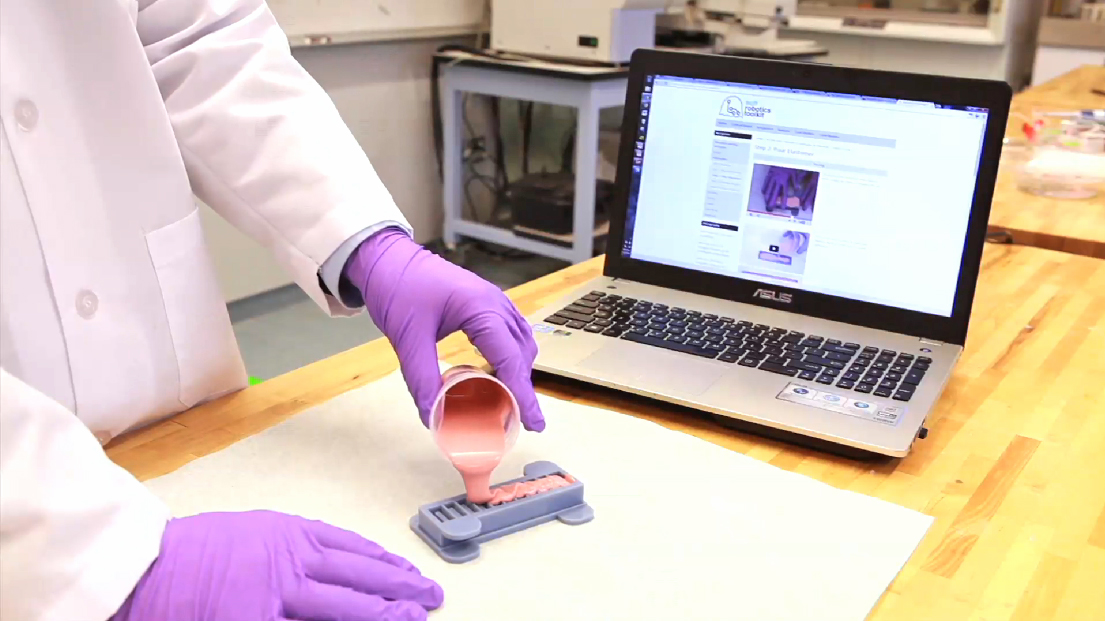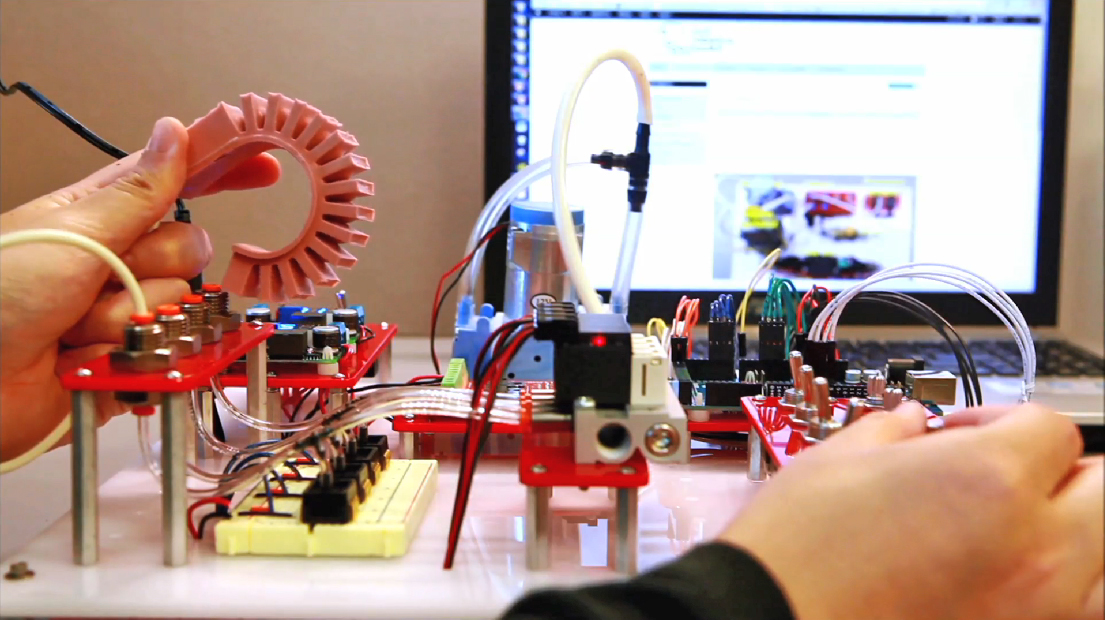Soft robotics ‘toolkit’ features everything a budding robot-maker needs
September 24, 2014

(Credit: Eliza Grinnell, Harvard School of Engineering and Applied Sciences)
Several Harvard University labs in collaboration with Trinity College Dublin have developed the Soft Robotics Toolkit — an online treasure trove of downloadable open-source plans, how-to videos, and case studies to assist users in the design, fabrication, modeling, characterization, and control of soft robotic devices.
With the advent of low-cost 3D printing, laser cutters, and other advances in manufacturing technology, soft robotics is emerging as an increasingly important field.
Using principles drawn from conventional rigid robot design, but working with pliable materials, engineers are pioneering the use of soft robotics for assisting in a wide variety of tasks such as physical therapy, minimally invasive surgery, and search-and-rescue operations in dangerous environments.
The kit will provide researchers with a level of detail not typically found in academic research papers, including 3D models, bills of materials, raw experimental data, multimedia step-by-step tutorials, and case studies of various soft robot designs.

(Credit: Eliza Grinnell, Harvard School of Engineering and Applied Sciences)
“The goal of the toolkit is to advance the field of soft robotics by allowing designers and researchers to build upon each other’s work,” says Conor Walsh, Assistant Professor of Mechanical and Biomedical Engineering at the Harvard School of Engineering and Applied Sciences (SEAS) and a Core Faculty Member at the Wyss Institute for Biologically Inspired Engineering at Harvard University.
By creating a common resource for sharing design approaches, prototyping and fabrication techniques, and technical knowledge, the toolkit’s developers hope to stimulate the creation of new kinds of soft devices, tools, and methods.
According to Walsh, who teaches a popular course in medical device design at SEAS and is founder of the Harvard Biodesign Lab, soft robotics is especially well suited to shared design tools because many of the required components, such as regulators, valves, and microcontrollers, are largely interchangeable between systems.
Dónal Holland, a visiting lecturer in engineering sciences at SEAS and graduate student at Trinity College Dublin, is one of the lead developers of the toolkit and is especially interested in the toolkit’s potential as an educational resource.
Harvard University | Discover the Soft Robotics Toolkit, a collection of shared resources to support the design, fabrication, modeling, characterization, and control of soft robotic devices.
“One thing we’ve seen in design courses is that students greatly benefit from access to more experienced peers—say, postdocs in a research lab—who can guide them through their work,” Holland says. “But scaling that up is difficult; you quickly run out of time and people. The toolkit is designed to capture the expertise and make it easily accessible to students.”

The most recent version of the open source fluidic control board incorporating improvements made by users of the toolkit (credit: Dónal Holland et al./Soft Robotics)
Just as open-source software has spurred far-flung innovation in computing, “open design” hardware platforms—coupled with advances in computer-aided engineering and more accessible prototyping capabilities—have the potential to foster remote collaboration on common mechanical engineering projects, unleashing crowdsourced creativity in robotics and other fields.
“Open design can have as disruptive an influence on technology development in this century as open source did in the last,” says Gareth J. Bennett, assistant professor of mechanical and manufacturing engineering at Trinity College Dublin and a coauthor of a paper in Soft Robotics that describes the toolkit development.
Much of the material included in the toolkit sprang from the labs of Robert J. Wood, Charles River Professor of Engineering and Applied Sciences at SEAS, and chemist George M. Whitesides, Woodford L. and Ann A. Flowers University Professor, two researchers whose work has helped establish Harvard as a leader in soft robotics. Wood and Whitesides are also core faculty members of the Wyss Institute.
Abstract of Soft Robotics paper
This article describes the development of the Soft Robotics Toolkit, a set of open access resources to support the design, fabrication, modeling, characterization, and control of soft robotic devices. The ultimate aim of the toolkit is to support researchers in building upon each other’s work, and thereby advance the field of soft robotics. An additional aim is to support educators and encourage students to pursue careers in engineering and science by making the resources as accessible as possible. The toolkit was developed and refined through a series of pilot studies and user tests. Specifically, the resources were used by students in a project-based medical device design course; volunteers from a variety of backgrounds tested the toolkit and provided feedback, and soft robotics researchers used the collection of resources and contributed to its development. Throughout all user studies, qualitative data were collected and used to guide improvements to the toolkit. This process of testing and refinement has resulted in a website containing design documentation describing general hardware control platforms and specific soft robotic component designs. The online documentation includes downloadable computer-aided design (CAD) files, detailed multimedia protocols for the fabrication of soft devices, tutorials and scripts for modeling and analyzing soft actuators and sensors, and source code for controlling soft devices. Successive iterations of qualitative data gathering and redesign have confirmed that the toolkit documentation is sufficiently detailed to be useful for researchers from a wide range of backgrounds. To date, the focus of the toolkit has primarily been fluid-actuated robotic systems, but the plan is to expand it to support a wider range of soft robotic-enabling technologies. The toolkit is intended as a community resource, and all researchers working in this field are invited to guide its future development by providing feedback and contributing new content.